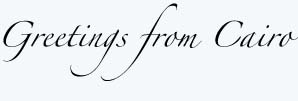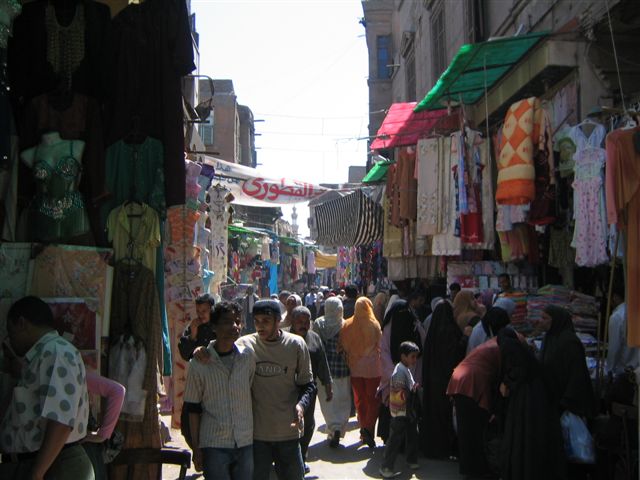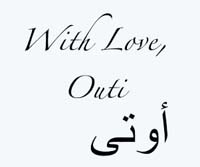

Greetings from Cairo part XI
Published in Ishtar 3/2008
Cairo - the Shopping Heaven
translated by Anu Toivonen
Once the plain has landed, the tourist will see a heartening sight: shops, side by side, mile by mile everywhere. The shopping opportunities seem endless and the fingers itch to touch the wealth of merchandise. The reality is different: you can manage on a short trip lasting only a week or two but when you live in Cairo you are surprised by many little details.
The shops are tiny, so their product selection is limited. It takes a long time to get the shopping done as you need to go to several different shops to buy everything you need and the shops are often on widely different locations. You can’t buy needles or thread at the draper’s, shoe polish in a shoe shop, or beds in a shop selling chairs. In a metropolis of over twelve million people there are only a few supermarkets.
Over-clothes and undergarments
On Talat Harb St and Qasr El Nil St, the two main thoroughfares in the city centre, there are clothes shops side by side with windows full of merchandise in many colours, and with ample decoration and detail: ribbons, sequins, beads, bows and buttons galore. The style is widely different from Finnish simplicity. Walking on the street, you can easily see the hottest colour combinations and latest fads. Brown and turquoise have long been popular, and now the abstract prints from the 1970s seem to be in vogue. The prices are deliciously low compared to the Finnish ones so you’re guaranteed to feel the shopping rush.
After a while, you start to see behind the glittering façade. Many shops sell exactly the same merchandise, the wonderful decoration has been haphazardly sown and the feminine ruffles have not been hemmed at all – as have so few other garments, so that the sleeves and the shirt hem will start to unravel in short order. The Egyptian laundry is still largely washed by hand, but after the garment has been subjected to the Finnish machine-wash a few times the sequins soon loose their sparkle. However, the largest problem with the clothes is the fitting as the Egyptians and the longer northern people are of decidedly different size – although even this does not fully explain the problem. In the shop windows, the blouses, skirts and trousers have been pinned to fit on the mannequin so the size and design will look good even though as much as half of the garment may be pinned out of sight. The assistants are eager to sell, however, so they equally eagerly offer seamstresses’ services. It is easy to see that if you take in over 10cm at the sleeves and the sides the proportions of the garment will drastically change ant the result will not be any better than the original. I once met an assistant who didn’t seem to grasp this, and she enthusiastically explained to me all the ways the garment could be improved by taking in at the seams: I politely but firmly said no.
I shudder to think of underwear: so far, I haven’t found any that would give the necessary support, fit well and be of high-quality. Luckily, the hard model used as the basis of dance costume tops is easily available although I fail to see how anyone can wear this hard cardboard model in everyday use though.
Leather
In addition to clothes shops, Talat Harb St also houses a concentration of shoe shops. At first, it may be difficult to grasp that the whole selection of shoes is available in the window and the few pairs of shoes on the inside are only there for decoration. The best way to buy shoes is to ask the assistant to join you outside and point out the ones you want. Many shoes look fine but the fit is not always so good so the only way to be sure is to carefully test before buying. I find various sandals to be the best fit as the designs closing over the toes have not lived up to their looks in practice. The assistant will assure you the shoes are made of genuine leather but this may not always be the case even in shops selling expensive design wear.
In addition to shoes, you will also find a generous selection of bags. The Egyptians love bright colours and decorative pendants. The Egyptian leather bags last long in use but most of the bags are made of other materials. In the Finnish winter, a bag made of artificial lather will soon harden and be impractical or impossible to use.
At the perfumery
Cairo is a pirate heaven when it comes to make-up products. You can often find a blue Dove-bird accompanied with the labels Dovu, Doev or Duvo and during the past few years, I have also become familiar with the labels of MexFacter, Max Factre, Lancomo and Lacome - some of these products are even decent in quality. Make-up products are cheap and you tend to buy them on an impulse. Some glittery eye shadows and nail polishes may even be flashier than their original western counterparts. Testers are rarely available and some customers have evidently tried out the merchandise - hygiene is not a priority and often there is only one sample of each product available: especially powder and make-up base are often sold like this.
In addition to make-up, perfumeries also offer cheap jewellery, perfumes, hair clips and ornaments, a few stationery products and a miscellaneous selection of ornaments and household necessities. At first, I kept wondering where the local women bought their make-up products, as these shops seemed to be more in the nature of general stores than respectable perfumeries.
Sale
The Cairene sale-season is still, after three years, quite an unsolved riddle. In Finland, there are three sales a year, you can prepare yourself beforehand and it is relatively easy to make bargains. Here in Cairo, this extravaganza follows partially the Islamic calendar, partially the western one and I am never able to anticipate it. One year a big Alfa-market had an unexpected clothes sale right before Christmas but after the holidays, only normal priced product were foe sale. You must also wait long and hard for the big reduction percentages: 10% is really common, but over 30% reductions are harder to find. One shop was advertising 75% reductions, but when I asked what products were reduced I was told it was a surprise. Excuse me? The customer may be pleasantly surprised by a larger-than-expected reduction?
Post-war-like shortage
The Egyptians will easily manage by local products as they are used to utilising what is available since childhood. A foreigner will sometimes find it more difficult to manage.
Finding the basic foodstuffs is easy, but their availability is not always guaranteed. It is easy to accept this when it comes to the imported items, but import is not always the source of the problems. My favourite juice, orange-pineapple, is one of the few available without added sugar. Produced by a local company, it has usually been readily available. For some reason, however, this brand was not available at the shops for a considerable time, almost a year in fact. It is no use asking the assistants when the product you want will be available again, as the answer is always ‘next week’ regardless of the actual delivery schedule.
Other basic foodstuffs with varying availability are yoghurt, fat-free milk, basmati rice and salted butter. You can find unsalted butter always and everywhere but there is only one brand of salted butter, and this only in one package size. Sometimes you can’t find it in the shops for a couple of weeks in a row and as the unsalted brand will not taste the same, you have to buy in a store of your brand whenever you can get it. Generally, it is a good idea to buy anything you might want whenever you can find it, irrespective of whether you already have it in the house or when you plan to use it, as there is no guarantee when it will be in the shops next. Once, I was lucky to find a popular Finnish brand of thin, dried rye bread in the shop: what a marvellous, although singular occasion! Fortunately I can completely rely on my visiting Finnish friends in this instance.
One great difference between the products used by me and those used by the Egyptians stems from national characteristics: the Finnish hair-type is widely different from the Egyptian one. The shampoos on the market here work reasonably well but the moisturizing hair-masks and more robust conditioners are a problem, and as the local oils make my hair look greasy even after the fifth rinse I have to bring these in from Finland.
Buying a nightstand
I needed to buy a bedside table: it is nice to have it so you can have a lamp beside the bed and have something to put your book on without needing to get up to do so. This mission is very typical here in Egypt: for a couple of hours I roamed around with a couple of local friends in the alleys selling furniture. There was furniture galore: wooden chairs, tables, sofas and beds in various stages of manufacture but only a couple of shops had bedside tables. The result proved poor as all the shops, without the exception of two, sold the same model. As I mentioned before, this is typical here: the same products are available everywhere and there is no desire for individuality or novelties.
Shopping tips for the next visit
Some excellent articles here are well worth lugging all the way home. A couple of outlet shops sometimes sell single specimens (design and size) of European clothes, and good looking, high-quality clothes in correct sizes can be found in these shops at a pittance. Unfortunately there is no guarantee of the selection available.
Scarves and shawls are available at every street corner and if the quality is not always high, the prizes are extremely low; and these are a good presents to bring home. I’ve found the best possible dancing shoes for performances here in Cairo – made in Egypt; cheap, enduring and suitable for all kinds of floor surfaces, these glitzy sandals are my absolute favourite.
Karkadeh, hibiscus tea, is drunk every day in Egypt; served cold or hot it is suitable both in the summer and winter. The glittery eye shadows I mentioned above are appropriate for every dancer’s beauty box, and as there is a wide choice of colours you can buy a matching shadow for each of your costumes.
All in all, as the quality of the merchandise in sot the same as at home, it is useful to examine every item and consider your purchases carefully even while in the throes of a shopping frenzy.

|
